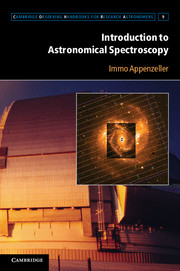Book contents
- Frontmatter
- Contents
- Preface
- 1 Historical Remarks
- 2 Spectroscopy in Present-Day Astronomy
- 3 Basic Physics of Spectral Measurements
- 4 Optical-Range Grating and Prism Spectrometers
- 5 Other Techniques for the Optical Spectral Range
- 6 Preparing and Reducing Optical Observations
- 7 UV, X-Ray, and Gamma Spectroscopy
- 8 Spectroscopy at Radio Wavelengths
- 9 Special Techniques of the FIR and Submillimeter Range
- 10 New Developments and Future Prospects
- Appendix: List of Acronyms
- References
- Index
9 - Special Techniques of the FIR and Submillimeter Range
Published online by Cambridge University Press: 05 January 2013
- Frontmatter
- Contents
- Preface
- 1 Historical Remarks
- 2 Spectroscopy in Present-Day Astronomy
- 3 Basic Physics of Spectral Measurements
- 4 Optical-Range Grating and Prism Spectrometers
- 5 Other Techniques for the Optical Spectral Range
- 6 Preparing and Reducing Optical Observations
- 7 UV, X-Ray, and Gamma Spectroscopy
- 8 Spectroscopy at Radio Wavelengths
- 9 Special Techniques of the FIR and Submillimeter Range
- 10 New Developments and Future Prospects
- Appendix: List of Acronyms
- References
- Index
Summary
So far, we have discussed two basic types of spectroscopic techniques. At high photon energies, the observations were based on the detection of individual photons. Their frequency was determined either by measuring their energy or by measuring their wavelength by means of optical effects. At low (radio) frequencies, the electromagnetic waves were directly recorded, and their frequency distribution was derived using electronic methods. As noted in Chapter 3 (Equation 3.42), under thermal equilibrium conditions, the detection of individual photons requires photon energies hv > kT. Thus, depending on the detector temperature, the transition between photon detection and radio-astronomical methods is expected to take place at FIR or submillimeter wavelengths. In practice, there exists a significant overlap of frequencies at which both types of detection methods can be used, and for which the preferred technique depends on the specific scientific objective. Moreover, in the submillimeter range it is sometimes of advantage to use bolometers, which record light indirectly by measuring the heat that is produced when photons are absorbed. Because of the choice of methods, special techniques have been developed for astronomical observations at these wavelengths, and sometimes combinations of radio and optical techniques are employed. A good example of the diversity of methods used in the FIR/submillimeter range are the three spectroscopic instruments of the Herschel Space Observatory (see Figure 9.4), which (as will be described later) use three different techniques.
The purpose of this chapter is to give a brief introduction to the special methods of the FIR/submillimeter range and to discuss their relative advantages and drawbacks for practical observations.
- Type
- Chapter
- Information
- Introduction to Astronomical Spectroscopy , pp. 214 - 223Publisher: Cambridge University PressPrint publication year: 2012

